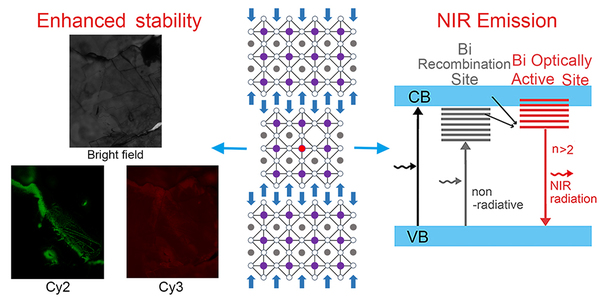Recently, SPST Lin Bolin’s group developed heterovalent doped 2D Ruddlesden-Popper organic lead halide perovskites and their work was published in Journal of Materials Chemistry A in an article titled “Bi3+ doped 2D Ruddlesden-Popper Organic Lead Halide Perovskites.”
Two-dimensional Ruddlesdan-Popper organic lead halide perovskites (2D RPPs) are a kind of semiconducting material that have attracted widespread research attention recently, due to their optoelectronic tenability and eminent photo-/chemical-stability, which have potential applications in the optoelectronic field. Meanwhile, heterovalent doping has been widely used as a classical strategy to manipulate semiconductor’s properties.
Lin Bolin’s group developed the first series of heterovalent-doped 2D RPPs via Bi3+ doping for (BA)2(MA)n-1PbnI3n+1 (BA=n-C4H9NH3+; MA=CH3NH3+; n = 1, 2 and 3), which allows for systematic investigations of the chemical doping behaviors as well as doping effects on photophysical behaviors and material stabilities. The authors found that a near infrared (NIR) emission can be induced by Bi3+ doping. Combining theoretical and experimental observation, two distinctive types of Bi3+ doping sites were found in different layer 2D RPPs, revealing the mechanism of the NIR emission. Furthermore, a significantly improved photostability and environmental stability for the 2D RPPs were observed upon Bi3+ doping and the mechanism of stability improvement was investigated using fluorescence microscopy. The researchers’ work provides an unprecedented strategy to improve the stability of perovskites and a new class of materials for device dimensionality engineering.
Graduate student Lyu Feiyi is the first author and the other co-authors are undergraduate student Zheng Xiaoqi, Wang Yingqiao, Shi Ruowen, Li Ziyue, Yu Jiase, and graduate student Yang Jianli. Assistant Professor Lin Bolin is the corresponding author. This work was supported by the Analytical Instrumentation Center of SPST and grants from the National Natural Science Foundation of China and ShanghaiTech University.
Read more at: https://pubs.rsc.org/en/content/articlepdf/2019/ta/c9ta04145a

2D Ruddlesden-Popper perovskites exhibit flexible light-emitting modulations and surprising stability improvements upon heterovalent Bi3+ doping.


